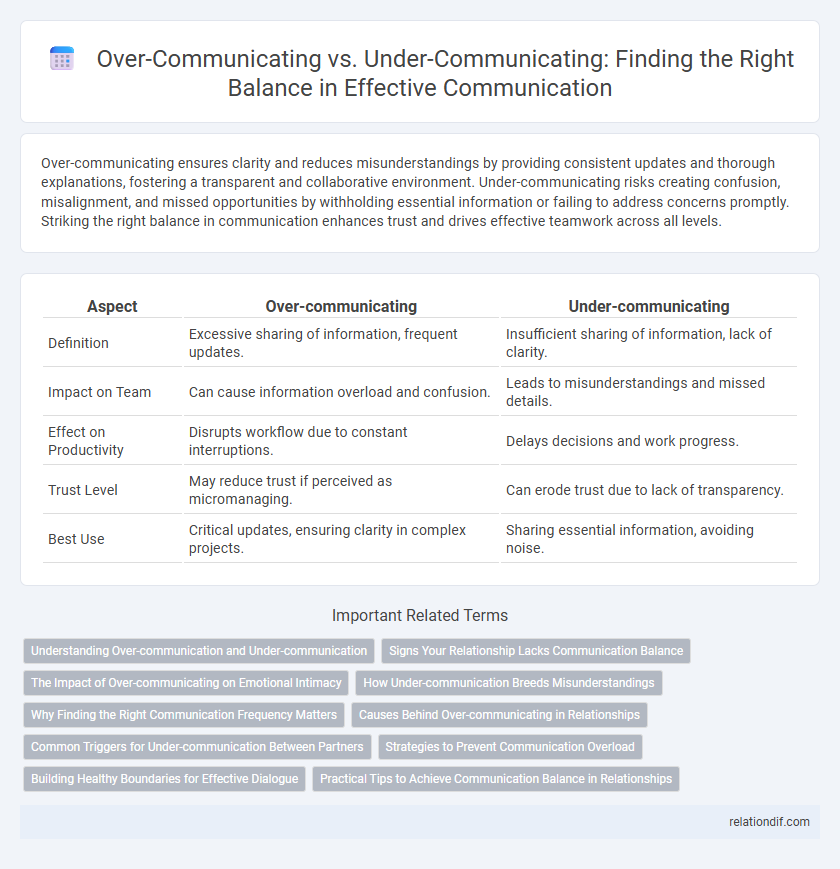Over-communicating ensures clarity and reduces misunderstandings by providing consistent updates and thorough explanations, fostering a transparent and collaborative environment. Under-communicating risks creating confusion, misalignment, and missed opportunities by withholding essential information or failing to address concerns promptly. Striking the right balance in communication enhances trust and drives effective teamwork across all levels.
Table of Comparison
| Aspect | Over-communicating | Under-communicating |
|---|---|---|
| Definition | Excessive sharing of information, frequent updates. | Insufficient sharing of information, lack of clarity. |
| Impact on Team | Can cause information overload and confusion. | Leads to misunderstandings and missed details. |
| Effect on Productivity | Disrupts workflow due to constant interruptions. | Delays decisions and work progress. |
| Trust Level | May reduce trust if perceived as micromanaging. | Can erode trust due to lack of transparency. |
| Best Use | Critical updates, ensuring clarity in complex projects. | Sharing essential information, avoiding noise. |
Understanding Over-communication and Under-communication
Over-communication involves sharing excessive information, which can lead to information overload and reduced message clarity, while under-communication results in insufficient information, causing confusion and misalignment within teams. Understanding the balance between these extremes is crucial for effective communication, as clear and concise messaging promotes better collaboration and decision-making. Employing feedback loops and active listening enhances comprehension, ensuring that the right amount of information is conveyed to meet organizational goals.
Signs Your Relationship Lacks Communication Balance
In relationships where communication balance is lacking, signs often include frequent misunderstandings and unresolved conflicts that escalate over time. Over-communicating can lead to emotional exhaustion and a sense of suffocation, while under-communicating often results in feelings of neglect and emotional distance. Recognizing these patterns early helps restore healthy dialogue, ensuring both partners feel heard and valued.
The Impact of Over-communicating on Emotional Intimacy
Over-communicating in relationships can overwhelm partners, leading to emotional fatigue and reduced intimacy. Excessive messaging or frequent check-ins may trigger feelings of anxiety or suffocation, hindering genuine emotional connection. Balancing communication frequency is crucial to maintaining trust and fostering authentic emotional intimacy.
How Under-communication Breeds Misunderstandings
Under-communication creates gaps in information flow, leading to unclear expectations and assumptions that distort the intended message. When key details are omitted or inadequately conveyed, stakeholders may misinterpret objectives, causing frustration and errors. Consistent, transparent communication is essential to prevent misunderstandings and maintain alignment within teams and organizations.
Why Finding the Right Communication Frequency Matters
Finding the right communication frequency ensures messages are neither overwhelming nor overlooked, optimizing team engagement and productivity. Over-communicating can lead to information fatigue, reducing message retention, while under-communicating creates gaps that cause confusion and misalignment. Balancing communication frequency fosters clarity, trust, and efficient decision-making within organizations.
Causes Behind Over-communicating in Relationships
Over-communicating in relationships often stems from anxiety or insecurity, prompting individuals to seek constant reassurance and clarity. This behavior can be caused by fear of misunderstandings, past experiences of neglect, or an intense desire to maintain emotional connection. Recognizing these underlying causes helps address communication imbalances and foster healthier interactions.
Common Triggers for Under-communication Between Partners
Common triggers for under-communication between partners include fear of conflict, lack of trust, and assumptions about the other's thoughts or feelings. Emotional barriers such as stress or insecurity often inhibit open dialogue, leading to misunderstandings. Identifying these triggers is essential for fostering transparent and effective communication in relationships.
Strategies to Prevent Communication Overload
Effective strategies to prevent communication overload include setting clear expectations for message frequency and prioritizing essential information to avoid overwhelming recipients. Utilizing concise messaging and appropriate communication channels enhances message clarity while minimizing noise. Implementing regular feedback loops ensures messages are understood and allows adjustments to communication practices for optimal engagement.
Building Healthy Boundaries for Effective Dialogue
Establishing clear boundaries in communication prevents the pitfalls of over-communicating, which can overwhelm dialogue and dilute key messages, while under-communicating risks misunderstanding and disengagement. Effective dialogue thrives on balanced information exchange, where participants respect limits that safeguard mutual clarity and emotional well-being. Prioritizing concise, purposeful sharing enhances trust, facilitates collaboration, and fosters a respectful conversational environment.
Practical Tips to Achieve Communication Balance in Relationships
Effective communication in relationships requires balancing clarity without overwhelming others. Utilize active listening and summarize key points to ensure mutual understanding while avoiding excessive repetition that can lead to frustration. Setting regular check-ins and clarifying expectations helps maintain transparency without crossing into over-communication.
Over-communicating vs under-communicating Infographic

 relationdif.com
relationdif.com